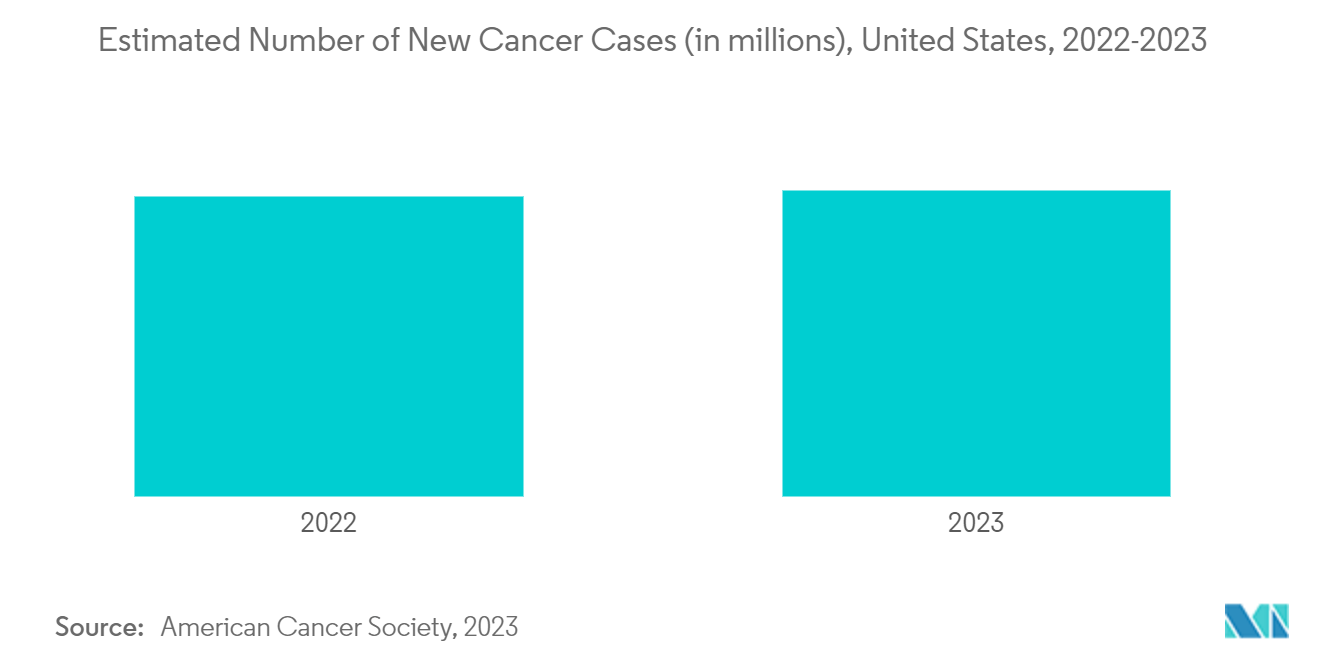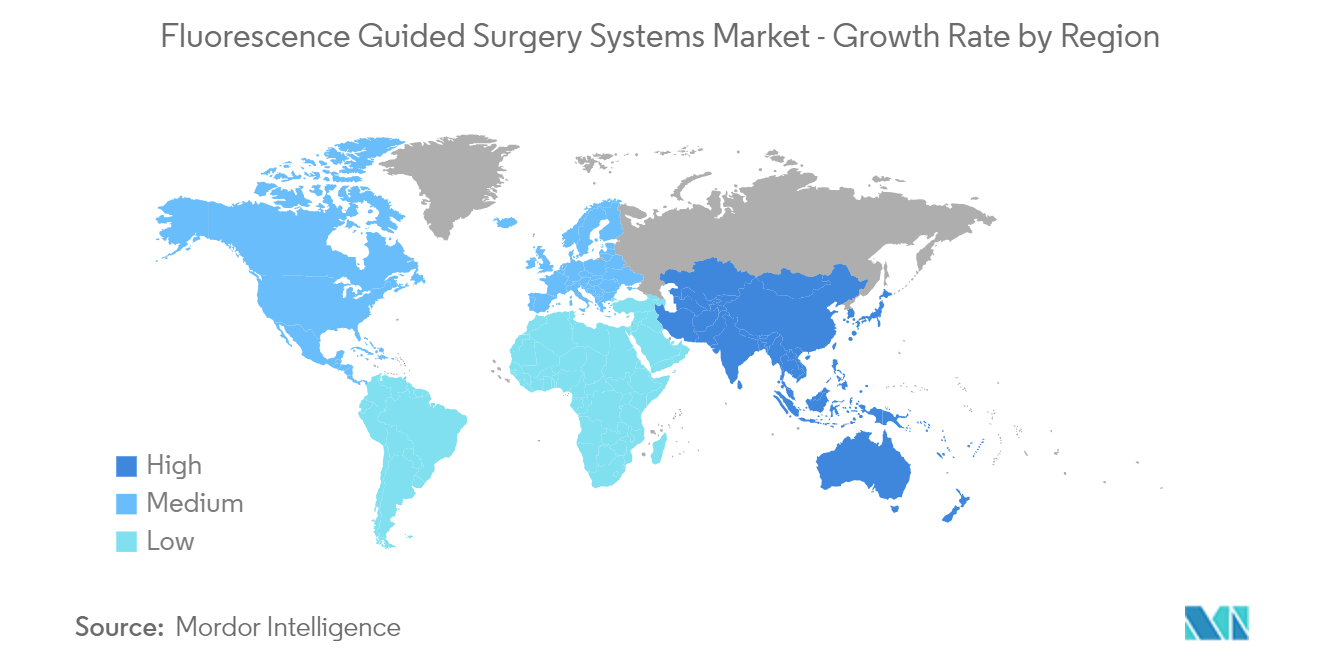Market Trends of Fluorescence-guided Surgery Systems Industry
Cancer Surgeries Segment is Expected to Hold a Significant Share Over the Forecast Period
The growth of the cancer surgeries segment is driven by an increase in the prevalence of cancer cases worldwide. The rising prevalence of cancer is expected to increase the number of cancer surgeries which will boost the demand for fluorescence-guided surgery systems that are used for cancer treatment. For instance, according to an article published by the Chinese Medical Journal in March 2022, China was experiencing a greater incidence of cancers. In 2022 approximately 4.8 million new cancer cases were diagnosed in China, out of which the most common was lung cancer. Such an increase in the prevalence of cancer is likely to boost the usage of fluorescence-guided surgery systems for cancer diagnosis, ultimately boosting segment growth.
Additionally, as per updates in January 2021, published by researchers at the University of New South Wales (UNSW) Sydney, the number of cancer patients requiring surgery each year is anticipated to increase to 13.8 million by 2040. According to their findings, the highest relative increase would occur in 34 low-income nations by 2040, with the number of cases requiring surgery expected to more than double (314,355 cases to 650,164). Such a huge rise in cancer surgeries will bolster the adoption of fluorescence-guided surgery systems across hospital settings, driving the segment's growth.
In addition, according to the study published in Frontiers in Neurology in June 2021, fluorescence-guided surgery (FGS) allows surgeons to see tumor tissue more clearly in the operating room, allowing for the most precise and safe removal of malignant brain tumors. Such studies will further lead to the growing adoption of these systems in tumor removal, driving the segment's growth.
Moreover, the rising grants and studies for the use of fluorescent probes in cancer surgery are expected to boost segment growth. For instance, in April 2022, the Imperial College awarded the Tate Group a grant to work on fluorescent probes for the visualization of tumors during cancer surgery. Similarly, in October 2021, Delray Medical Center published a breakthrough study focusing on 5ALA (fluorescent-guided surgery) for glioblastomas with the team at Mount Sinai Hospital.
Thus, the rising number of cancer cases coupled with the increasing number of cancer surgeries and the increasing research on fluorescence-guided surgery systems for tumor surgeries is expected to boost segment growth.

North America is Expected to Hold a Significant Share in the Market Over the Forecast Period
The fluorescence-guided surgery (FGS) system market is expected to have significant growth in North America owing to the high burden of chronic diseases like cancer and cardiovascular disease and the high awareness and demand for advanced surgical procedures in the country over the forecast period.
For instance, according to the American Cancer Society's (ACS) report for 2021 and 2023, the estimated incidence of cancer cases increased from 1.91 million in 2021 to 1.96 million in 2023 in the United States, an increase of more than 60 thousand cases in just two years. The data shows a rapid increase in the incidence of cancer cases in the country, and over the forecast period, the incidence of cancer is further expected to increase. Similarly, according to the Canadian Cancer Society (CCS) 2022 report published in November 2022, cancer is responsible for one of the highest healthcare burdens in Canada, and the incidence of cancer is increasing in the country. As per the CCS's 2022 report, about 233.9 thousand new cases of cancer were reported in 2022 in Canada, as compared to 229.2 thousand in 2021. This is likely to augment the adoption of fluorescence-guided surgery systems across healthcare settings in this region for cancer surgery, in turn driving the market growth in North America.
Moreover, as per the American Heart Association's report published in 2021, it is estimated that, by 2035, more than 130 million adults in the United States may have some heart disease. This is also expected to have a significant impact on the angiography procedures where fluorescence imaging has its application, which is expected to have a significant impact on the market studied.
Furthermore, the ongoing clinical trials in the country involving fluorescence-guided surgery (FGS) systems are expected to have a positive impact on the market's growth as these clinical trials evaluate the safety and effectiveness of FGS in hospital settings, and positive outcomes from these trials are further expected to advance the usage of FGS systems. For instance, in November 2021, a clinical trial was posted on the United States National Library of Medicine (ClinicalTrials.gov) site. The objective of the research study was to determine if 5-ALA can be effectively used in FGS for different types of head and neck cancers and if it will improve survival, tumor regrowth, and other outcomes for patients. The study was sponsored by Icahn School of Medicine at Mount Sinai in collaboration with NX Development Corp. Further, the trial's expected primary completion date is January 2024.
Therefore, owing to the above-mentioned factors, such as the rising prevalence of target diseases such as cancer and cardiovascular diseases, and the rising number of clinical trials, the market for fluorescence-guided surgery systems is expected to grow in North America.


